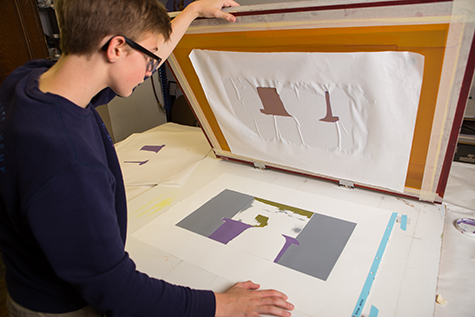The Essential Guide to Understanding Screen Printing and Its Versatile Uses
Screen printing has a rich history that goes back to old times, developing into an innovative strategy utilized throughout different industries today. This guide discovers the intricacies of the screen printing process, describing its applications in marketing, home, and fashion décor - 10:9 Design Screen Printing Texas. Comprehending these principles can open up innovative possibility for both creative and industrial projects. The following sections will disclose vital suggestions and techniques to boost one's screen printing ventures
The Background of Screen Printing
Although screen printing has origins that trace back centuries, its evolution shows the imaginative and technical improvements of different societies. Coming from ancient China, the method was initially made use of for embellishing fabrics and later infect Japan, where it came to be indispensable to Ukiyo-e woodblock printing. The approach changed to Europe in the 18th century, where it obtained popularity among craftsmens and industrial printers. The creation of image emulsion in the 20th century transformed screen printing, permitting more detailed designs and higher effectiveness. Artists like Andy Warhol further propelled its appeal, utilizing the medium to produce legendary works that combined commercialism and art. By the late 20th century, screen printing had actually developed itself as a flexible technique, utilized in vogue, advertising, and art. Today, it remains to progress, incorporating electronic innovation and expanding its applications throughout different markets.
The Screen Printing Process Explained
Screen printing transforms imaginative visions right into substantial designs via a series of precise steps. An image is produced and then transferred onto a screen, usually made of great mesh textile stretched over a framework. A light-sensitive solution is used to the screen, which is revealed to light, setting in areas not covered by the image. After cleaning out the unhardened emulsion, a pattern is formed.
Next off, the screen is positioned over the substrate, whether it be fabric, paper, or one more material. Ink is after that pushed through the open areas of the stencil using a squeegee, transferring the design onto the substrate below. This process can be duplicated for multiple colors, calling for separate displays for each color. Lastly, the published thing is healed utilizing warm to guarantee the ink sticks effectively, causing a resilient, lively layout on-line.
Kinds Of Screen Printing Techniques

Furthermore, specialty techniques, such as discharge screen printing, remove color from the fabric to produce softer prints, while aluminum foil screen printing applies metal aluminum foil to attain a glossy finish (10:9 Design Abilene). Each technique uses distinct qualities, catering to numerous creative needs and production ranges, ultimately increasing the go to this website opportunities within the screen printing domain
Applications of Screen Printing in Different Industries

In addition, the signs and marketing industries make use of screen printing for developing eye-catching display screens and banners. This approach permits bold colors and elaborate styles that catch focus. In electronic devices, screen printing is utilized for applying conductive inks to motherboard, important for part connections. The home decoration sector welcomes screen printing to create distinct styles on textiles and wall art. Generally, screen printing works as a crucial tool across diverse fields, enhancing products with personalized and visually appealing graphics.
Tips for Effective Screen Printing Projects
While undertaking a screen printing project, careful attention to information can considerably boost the last end result. Choosing premium materials is important; this includes the screen, inks, and substrates. Making use of ideal mesh matters can impact ink deposition and detail resolution. Prep work is discover here just as crucial; complete cleaning of screens and correct direct exposure times guarantee crisp prints.
Next, exact registration is crucial for multi-color prints. Using alignment devices can assist achieve precise layering. In addition, testing prints on scrap materials before production aids determine potential concerns without losing resources.

Regularly Asked Concerns
What Products Are Finest for Screen Printing on Material?
Cotton and polyester blends are optimal for screen printing on material because of their toughness and ink absorption. In addition, specialized textiles like silk or canvas can create special structures and surfaces, enhancing the overall layout top quality.
Just how Do I Tidy and Maintain Screen Printing Equipment?
To clean and maintain screen printing tools, one need to routinely wash displays with ideal solvents, check squeegees for wear, lubricate relocating parts, and store all things in a completely dry, dust-free environment to prolong their life-span.
What Are the Environmental Impacts of Screen Printing?
Screen printing can have substantial environmental impacts, consisting of chemical waste from inks and solvents, water use throughout cleaning procedures, and energy intake. Lasting practices and environmentally friendly products are essential for lessening these negative results.
Can Screen Printing Be Done in your home Effectively?
Screen printing can be successfully done at home with the best products and techniques. Enthusiasts can create high quality prints, though success relies on their skill degree, equipment, and understanding of the procedure involved.
What Are the Expenses Related To Starting a Display Printing Business?

Beginning a screen printing business includes expenses for tools, products, and workspace. Preliminary costs commonly vary from a few hundred to several thousand dollars, depending upon the range, top quality of machinery, and desired production capacity.
Screen printing has a rich history that dates back to ancient times, progressing right into an innovative strategy made use of throughout numerous industries today. Another technique, rotary screen printing, employs cylindrical screens, assisting in constant printing on textile rolls, thereby enhancing efficiency for large-scale productions. Additionally, specialty strategies, such as discharge screen printing, get rid of color from the textile to produce softer prints, while foil screen printing applies metallic aluminum foil to attain a glossy coating. In the style market, screen printing is commonly utilized to produce dynamic designs on garments, making it possible for brand names to display their unique designs. Cotton and polyester blends are ideal for screen printing on fabric due to their durability and ink absorption.